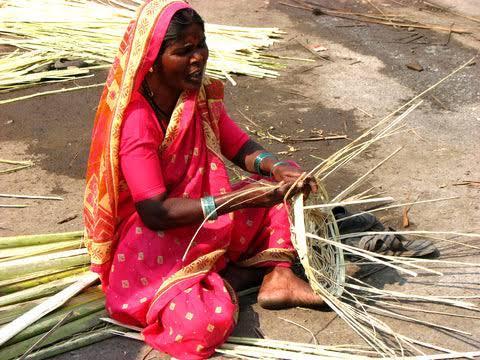NANDURBAR
Artforms
Last updated on 22 July 2025. Help us improve the information on this page by clicking on suggest edits or writing to us.
Uli
Uli is a festival celebrated in Gend Village, Nandurbar, to mark the arrival of spring through a vibrant performative tradition. The festival, rooted in the culture of the Pawara community, centers around the folklore of Raja Phanta and Uli-Jugan, a devi who is often also seen as a dakin (witch). The festival comes to life around a bonfire, which is said to perhaps demonstrate renewal and divine presence.
Central to Uli are the expressive enactments by male performers who take on roles such as Raja Phanta, Ganda Thakur, and Uli herself. The art form is visually striking, with performers donning peacock feather headgear (Budhiyo) and bamboo hats (Bawa). Supporting figures like the Niskya (animal mask wearers) and Rayas (men in women’s attire) heighten the rhythm and visual richness of the performance, making Uli a deeply layered display of storytelling and movement.
Sibli
The Sibli is a traditional basket dance performed during Bhil weddings in Nandurbar. The baskets, made from bamboo, are decorated with mirrors and colorful thread flowers. These baskets carry essential items for the bride, such as her sari and ornaments, presented by the bridegroom’s family. A member of the marriage party carries the Sibli while performing a lively walk as part of the ceremony.
Bamboo Weaving
Bamboo weaving is a common craft in Nandurbar. While the origins of the craft are unclear, it has been an important part of the local culture for generations.

Artisans use bamboo to create functional items like baskets, mats, and furniture, as well as decorative products for sale. The process involves selecting and preparing bamboo stalks, which are then woven into various products using traditional tools.
Textile Industry
Nandurbar’s textile industry plays a significant role in the local economy and is recognized as the district’s One District One Product (ODOP). The industry, concentrated in Navapur, includes 14 textile mills that produce cotton fabric using both traditional and modern techniques. The industry continues to provide employment and supports local textile craftsmanship.
Artists
Gosa Kharde
Gosa Kharde is an artist from Nandurbar, and his paintings reflect the history and pastoral life of his community. His work is deeply influenced by his cultural heritage, and it often conveys social messages related to the struggles and traditions of his people.
![Gosa Kharde[1]](/media/culture/images/maharashtra/nandurbar/artforms/gosa-kharde1-e074408f.png)
Nature plays a prominent role in his art, and he frequently depicts the landscapes, flora, and fauna of Nandurbar. His paintings also highlight local festivals and customs, and they serve as a medium to raise awareness about social issues affecting the community.
Sources
Nandurbar ODOP Textiles. Maitri.https://maitri.mahaonline.gov.in/HTMLTemplat…
Prof. Manda A. Gavit & S. R. Chaudhari. Eco-friendly art of Bhil tribe in Nandurbar district (MS). Scholarly Research Journal for Interdisciplinary Studies.
Tribal Paintings. Raj Bharti Crafts.https://www.rajbharticrafts.com/en-in/collec…
Wild Films India. 2020. Tribal men from Pawara community dance and play music during Uli festival | Genda village. YouTube.https://www.youtube.com/watch?v=EInr5w7nFxc
Last updated on 22 July 2025. Help us improve the information on this page by clicking on suggest edits or writing to us.